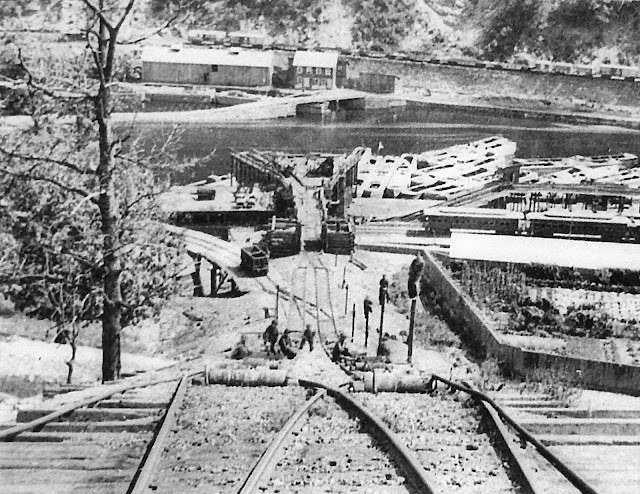In 1828, state-of-the-art transportation technology would come to the Pennsylvania mountains in the form of the Mauch Chunk and Summit Railroad. It was built to transport coal from the top of the mountains to the canal below. It was not the first railroad in the United States, but it existed at a time when many railways were still experimental in nature, and the industry was taking baby steps into becoming the modern form of transportation of the day, and displacing the canal, which was still king.
The story actually begins in 1792, when Anthracite coal was first discovered in the area. In attempting to bring the coal to Philadelphia markets, 100 miles away, Josiah White and Erskine Hazard purchased land at Mauch Chunk. "They built first a road, then a gravity railroad, to bring the coal down from Summit Hill to their new village of Mauch Chunk. Here shallow boats were loaded with 8 to 10 tons of coal. The boats went down the Lehigh through a series of low dams with gates that could be opened to let them float over the rocks down to Easton, then ride the Delaware River to Philadelphia." (Pennsylvania Historical Marker - HMDB)
 |
"Looking down the Switchback Gravity Rail that brought coal down the mountain to be loaded first on to canal boats and later on to rail cars." (Pennsylvania Historical Marker - HMDB)
|
While it was not the intent of the of the owners to create a line to carry passengers, the novelty of the experience spawned people to ride it for the experience alone, and it would become a tourist draw to the area. Not bad for a project strictly built for transporting coal. As a byproduct, it was one of the first operational railroads of a substantial length to carry passengers in the US, and reached over 100,000 riders in some years.
This is sometimes referred to as the Switchback Gravity Railroad such as in the
planning study for the historic preservation of the area's industrial heritage.
The Webster's Dictionary definition of a roller coaster is as follows: : an elevated railway (as in an amusement park) constructed with sharp curves and steep inclines on which cars roll. Despite this definition, coasters, particularly modern ones, obviously have little to do with conventional railways, as their tracks are quite articulated, can invert (something probably only The Polar Express can do), and their trains are far more technical than a traditional railway. But with that thought in mind, in an evolutionary sense, the Mauch Chunk Switchback Railway represents the common ancestor between modern day railroads and modern day roller coasters.
 |
The 'Up Route' cable Railway addition of 1846-47. Wikipedia Commons.
|
The original iteration of this operation used animal power. Mules hauled the empty coal cars to the summit and were sent down in the last batch of cars along an operation that would take about 4-5 hours. By the 1840's,
a down track and steam power had greatly reduced this trip length.
 |
"Down Among the Coal Mines -- Chutes Loading the Canal-Boats on the Lehigh Canal, a wood engraving published in Harper's Weekly, February 1873. Anthracite Coal was loaded at the foot of Mount Pisgah from above historic Mauch Chunk (present-day Jim Thorpe, PA). At the top of the image the visible railway 'Wye' is the cross-over between the gravity railroad down track and the cable railroad and inclined plane up railway of the Summit Hill and Mauch Chunk Railroad (aka: 'Mauch Chunk Switchback Railway'; the second operating railway in the country. The railway is considered the first roller coaster in the world and did a tourist trade as early as 1827; and ended its life serving such tourists between the 1870s and 1931." (Wikipedia Commons)
|
This operation for hauling coal would become obsolete in the 1870's with the completion of the
Hauto Tunnel. However, tourists still continued to flock to the line, even in spite of the fact that a railroad was no longer a future technology, but the area was often referred to as the "Switzerland" of the United States for its incredible scenic views, and thus it continued on as perhaps the first heritage railway in the United States.
 |
| Most, but not all, of the operation is on available topo maps. This is from the 1889 USGS Hazleton map. |
Cementing the line's status as the missing link between railroad and roller coaster would come the following decade. In 1884, the Mauch Chunk Scenic Railway would be the inspiration for LaMarcus Thompson's
Switchback Railway roller coaster at Coney Island, considered the first roller coaster in the US that was actually designed as such.
 |
| Switchback Railway at Coney Island. (Gothamist) |
Featuring 600 feet of track with heights of up to 50 feet and speeds of an eye-popping six miles per hour, the ride was nonetheless incredibly thrilling to amusement park goers of the day, even if most coasters designed for children today are faster.
By 1932, the novelty had died down, and the trifecta of World War I, the coming of the automobile and the Great Depression had impacted the bottom line such that the operation was no longer profitable, something this line would share with numerous railways across the US. Today, much of the right of way and history of the operation has been preserved as the
Switchback Railway Trail.
Thanks as always for reading!








Comments
Post a Comment